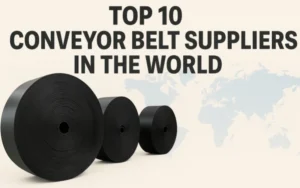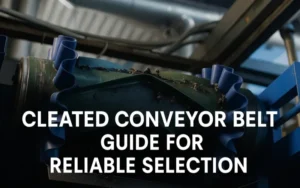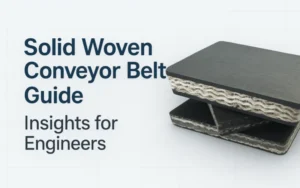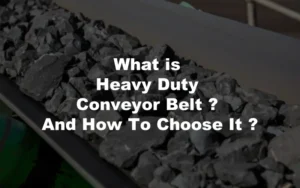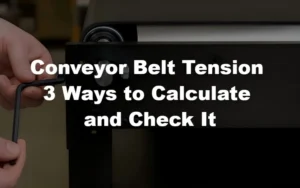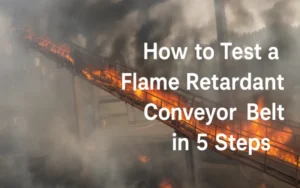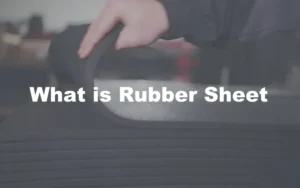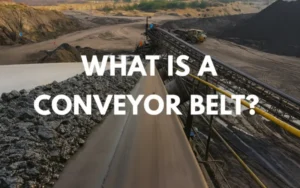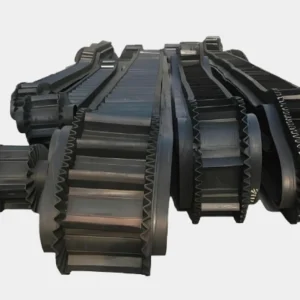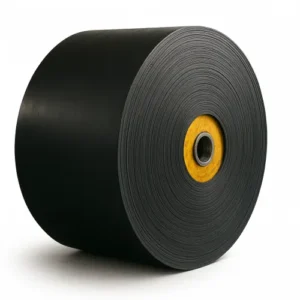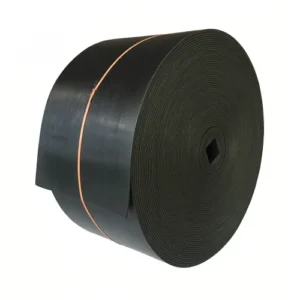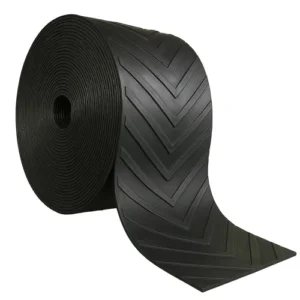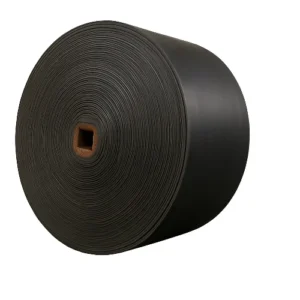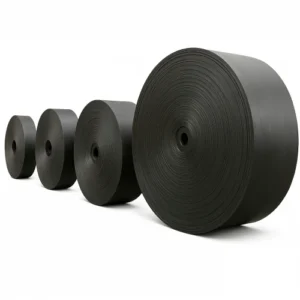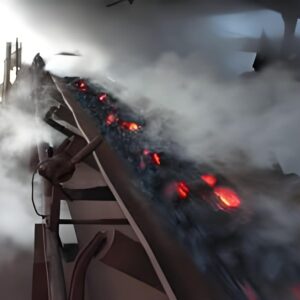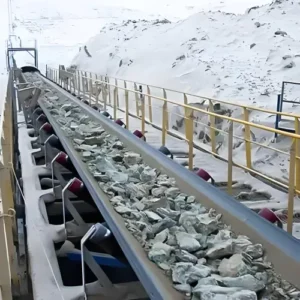1. Why Gravel Conveyor Belts Matter in Heavy-Duty Projects
At large-scale worksites, where the terrain is rough and the pace is unforgiving, gravel conveyor belts quietly carry the load—literally. Whether it’s coarse rock, loose sand, or compacted dirt, these systems do the heavy lifting behind the scenes, moving bulk material with calm efficiency while everything else keeps rushing forward.
Their value doesn’t stop at movement. The right gravel conveyor belt is built for wear. With high tensile strength and strong abrasion resistance, it keeps running long after other equipment needs repair. From muddy construction zones to crushing sites, it delivers consistency where it’s needed most.
There’s also something deeply practical about them. A well-placed gravel conveyor belt reduces truck movement, cuts labor needs, and limits environmental impact. For industries focused on deadlines and safety, that’s not just an upgrade—it’s a necessity.
As demands grow heavier and expectations tighter, one thing stays dependable: the power of heavy-duty conveyor belts in efficient gravel handling. Without them, the entire system would feel the drag.

2. The Role of Gravel Conveyor Belts in Modern Material Transport
In the world of infrastructure, speed isn’t just a preference—it’s a demand. And gravel conveyor belts have become essential tools in meeting that demand. Their purpose goes far beyond simply transporting materials. They create a rhythm to the workflow, a dependable line of motion that transforms how we move gravel, sand, rock, and soil.
On construction sites, especially those spread across large distances or uneven terrain, traditional transport methods often fail to keep up. Trucks may get stuck. Manual labor slows down. But a properly set up gravel conveyor belt glides through these challenges. It doesn’t just carry material—it reshapes how projects are executed. The ability to move tons of aggregate continuously and automatically leads to faster groundwork, cleaner sites, and fewer delays.
In construction conveyor systems, this reliability is critical. By maintaining steady delivery, gravel conveyor belts reduce bottlenecks and prevent crews from waiting around for materials to arrive. And in industries like landscaping or roadwork, where surface layering is everything, a consistent flow of aggregate can mean the difference between a smooth foundation and a costly redo.

There’s also a sustainability angle. With the right gravel conveyor belt, companies cut down on fuel usage from trucks, lower their labor intensity, and reduce site congestion. That’s not just good for budgets—it’s a win for environmental impact too. Efficient bulk material handling starts with choosing the right belt, one built to handle rough materials while minimizing energy waste.
And in the background of all this performance is durability. These aren’t fragile machines. A top-grade gravel conveyor belt is designed for rough conditions—wet, dusty, abrasive. With reinforced layers and careful material selection, it holds up under pressure, requiring fewer repairs and less downtime. That kind of longevity directly impacts overall project costs and schedules.
Ultimately, the importance of these systems isn’t just in what they move—but in how they move it: efficiently, reliably, and without interruption. In modern construction, that kind of reliability is everything. That’s why more contractors are turning to heavy-duty conveyor belts as the backbone of their operations, especially when precise, efficient gravel handling is non-negotiable.

3. What a Gravel Conveyor Belt Really Does
If you’ve ever been to a construction site or seen piles of gravel being moved around, chances are a gravel conveyor belt was doing the hard work. It’s a long, moving belt—kind of like an endless rubber road—that carries rock, sand, or dirt from one place to another. Simple in idea, but it saves a ton of time and labor.
Instead of using trucks or shovels, the gravel conveyor belt keeps things moving on its own. You load one end, and the materials just ride along to where they’re needed. Whether it’s laying a road or filling in a site, this moving belt keeps everything flowing without the stop-and-go of other methods.
These belts are built tough. They have to deal with sharp stones, heavy weight, and dirty conditions all day long. That’s why they’re made with strong materials and don’t tear easily. Some are used on flat ground, others are tilted to move materials up a slope. You’ll find them at job sites, mines, even landscaping projects.
At the end of the day, a gravel conveyor belt just makes things easier. It speeds up the job, keeps the site cleaner, and helps teams work more smoothly. In any job that deals with lots of loose material, it’s one of those tools you’ll wonder how you ever worked without.

4. To cope with harsh material environments, conveyor belts must be “hardcore” enough
In the work site where sand, cement, and gravel are flying, the gravel conveyor belt is the most silent and laborious role. It never stops, but is often overlooked. Heavy loads, impacts, dust, moisture, rough particles – these are all testing its limits, and none of them are gentle.
A truly reliable conveyor belt must be able to withstand the continuous backlog of weight and not loosen or break due to excessive tension. Tensile strength is not just talk on paper, it is related to whether the entire project can move forward steadily. Once there is a problem with the belt, the site is equivalent to a shutdown, and the cost begins to “burn money”.
It is normal to be rubbed and scratched by countless stones. Without sufficient abrasion resistance, cracks and wear will soon appear on the surface of the belt, which will affect efficiency at the least, and the entire belt will need to be replaced at the worst. The high wear-resistant structure can withstand this kind of grinding day after day, allowing the system to continue to operate longer and more stably.

The stones on site range from fine sand to coarse gravel, and there is no standard shape. The belt must be strong enough and flexible enough. Otherwise, it will break easily if it is too rigid, and it will not be able to support the load if it is too soft. The real design of heavy-duty conveyor belts is to find a balance between these two contradictions.
A high-quality gravel conveyor belt will not be ostentatious, but it can make the whole project less wrong, less downtime, and more money. This calm sense of reliability is the confidence that many bosses would rather spend more budget to get.
From a longer-term perspective, durable belts mean less maintenance and less downtime, a smoother team, more guaranteed progress, and better response to emergencies. If you want to achieve truly efficient gravel handling, this step really cannot be skipped.
5. Gravel Conveyor Belt Types: Matching the Right Belt to the Toughest Jobs
Choosing the right gravel conveyor belt isn’t just about moving material—it’s about keeping your operation running clean, efficient, and profitable.
For heavy loads and long distances, heavy-duty conveyor belts are the first line of defense. Designed with steel cord structures like ST6300, they can move up to 2,000 tons per hour without stretching or tearing. After switching to this type, a copper mine in Chile saw a 67% drop in belt tear failures—proof that strength matters when tons are on the line.
When dust control is critical, pipe conveyor belts change the game. Their fully enclosed design cuts dust leaks by 95% and handles curves with a tight 40-meter turning radius. At Hai Phong Port in Vietnam, these belts helped a cement project pass ISO 14001 certification and saved around $1,200 daily in cleaning costs.
Handling messy, uneven materials like crushed stone or demolition waste? Trough conveyor belts get it done. With a 35° deep groove design and certified abrasion resistance (DIN 22102), they cut material spillage dramatically. Jakarta’s aggregate plants reported a 41% boost in transport efficiency on 30-degree slopes after upgrading.
When space is tight and silence matters, Beumer technology pipe belts lead the way. They handle 90-degree turns without a fuss and keep noise levels below 70 dB. In Singapore, one recycling company used them to build a dust-free, fully enclosed system inside a compact 200m x 80m plant.
Picking the right gravel conveyor belt isn’t about guessing—it’s about matching real-world demands with belts tough enough to handle the job without missing a beat.

6. Designing Gravel Conveyor Systems: Beyond Equipment, It’s Full-Site Engineering
A gravel conveyor belt isn’t just about connecting two points—it’s about connecting the whole operation without wasting energy, causing dust storms, or draining your budget.
At a copper mine deep in Chile’s Atacama Desert, a poorly designed 3.2 km conveyor added $1.27 million in unexpected energy costs per year. The lesson? Conveyor systems aren’t just equipment—they’re full-blown strategies. Terrain, material properties, and local environmental rules all need to be part of the blueprint.
6.1 Custom engineering beats one-size-fits-all.
When Brazil’s Carajás Iron Mine faced a 12% belt slippage rate on steep slopes, standard belts failed miserably. Tiantie’s team didn’t just recommend a new belt; they built a solution. A 38mm corrugated sidewall belt combined with a hydraulic dynamic centering system stabilized loads of 1,500 tons per hour on 17° slopes. Energy use dropped by 18%, and maintenance went from monthly to once per quarter. This kind of precision comes from flexible manufacturing across Tiantie’s 20 production lines, tweaking everything from rubber formula to belt core to match each project’s DNA.

6.2 Pipe conveyors lead the environmental revolution.
At Hai Phong Port in Vietnam, open belts once triggered 23 dust complaints per month from angry residents. Tiantie replaced them with a sealed pipe conveyor belt system, dropping dust levels to 10mg/m³—matching strict EU IPPC standards—and cutting operating noise from 85 dB to 68 dB. Plus, the modular design slashed future expansion costs by 35%. It’s the same thinking that now powers Saudi Arabia’s NEOM zero-carbon city projects.
6.3 Energy savings are won millimeter by millimeter.
Every degree of slope matters. In Jakarta’s recycling center, Tiantie engineers used 3D modeling to redesign a 12° uphill section to just 9°, paired with low-rolling-resistance rubber layers. The result? Energy usage dropped from 18.7kW to 15.2kW per kilometer. That kind of micro-optimization comes from Tiantie’s database of over 5,000 friction coefficient tests.
Smart design isn’t just smart—it’s survival. A gravel conveyor belt that fits the land, the load, and the future is what keeps projects moving profitably.

7. Breaking the 24-Month Conveyor Belt Curse: Real Fixes for a Tough Industry
In the gravel world, everyone knows the ugly truth: most gravel conveyor belts barely survive 24 months. Cracks on the surface, edges peeling off, internal core snapping apart—it’s a vicious cycle of replacing, repairing, and replacing again. But why does it keep happening? It comes down to three problems: bad materials, bad design, and bad maintenance.
7.1 Material quality is the first battle.
Tests show belts made with more than 30% recycled rubber lose 42% of their wear resistance. Their ability to bend and flex drops to just 58% of what pure natural rubber belts can handle. Worse, if the bonding strength between fabric and rubber falls below 8kN/m—the ISO 252 threshold—the risk of layer separation under hot and wet conditions rises sharply. Even when belts look fine on the outside, after 18 months, steel cords inside may already have lost 19% to 37% of their breaking strength. That’s why sudden belt snaps almost always happen late in the service life.

7.2 Design mistakes silently destroy belts.
When material piles up just 15% higher than planned, edge friction heat can spike to 140°C—way beyond rubber’s tolerance. This weakens the belt from the sides inward. A smart V-shaped chute design can fix this, balancing the load so belt usage rates climb above 92% and extending lifespan by more than 40%. In steep applications over 12°, flat belts face 2.3 times more wear from material slipping. Deep-trough belts with anti-slip teeth spread the pressure better, lowering surface stress by 67%.
7.3 Maintenance gaps are where belts quietly die.
A scraper blade worn by just 0.5mm drops cleaning efficiency by 35%, leaving debris to act like sandpaper, grinding down the rubber cover. Dry roller bearings double the rolling resistance, wasting an extra 18kW·h of energy per kilometer. Tiny details ignored turn into big, costly breakdowns.
7.4 The real breakthroughs aren’t magic—they’re smart choices.
- Molecular-level material upgrades: Combining SBR rubber with nylon fabric boosts wear resistance beyond 180mm³ (DIN 53516) and improves UV resistance by 2.6 times over traditional materials.
- Smart monitoring: Embedded fiber sensors catch steel cord stress changes, triggering alerts 200 hours before serious cracks form, cutting sudden break risks to below 0.3%.
- Reliable life prediction: Testing under ISO 283:2020 standards—100,000 flex cycles, 2,000 hours of hot-humid conditions—builds life models accurate within ±8%.

Today, pushing beyond 24 months is no longer a dream. The real challenge is mindset: moving from cheap, short-term buys to building full-chain belt management systems—from selection to installation to maintenance. Only then will the industry truly leave behind the cost trap and step into an era of long-term value.
8. Leading Brands in Gravel Conveyor Belt Manufacturing
| Tiantie Industrial | https://conveyorbeltchn.com |
| Bridgestone | https://www.bridgestone.com/ |
| Phoenix | https://phoenix-cb.com/ |
| Contitech | https://www.continental-industry.com/en |
| Fenner Dunlop | https://fennerdunlopamericas.com/ |
| Flexco | https://www.flexco.com/NA/EN/Flexco.htm |
8.1 Tiantie Industrial
Known for integrating smart technology into traditional belt manufacturing, Tiantie Industrial offers ultra-wide (up to 3.2m) gravel conveyor belts with nano-ceramic coatings, reducing surface friction to 0.25. Their distributed fiber sensor system predicts steel cord fatigue 300 hours before failure, making them a strong player in the mid-to-high-end global market.
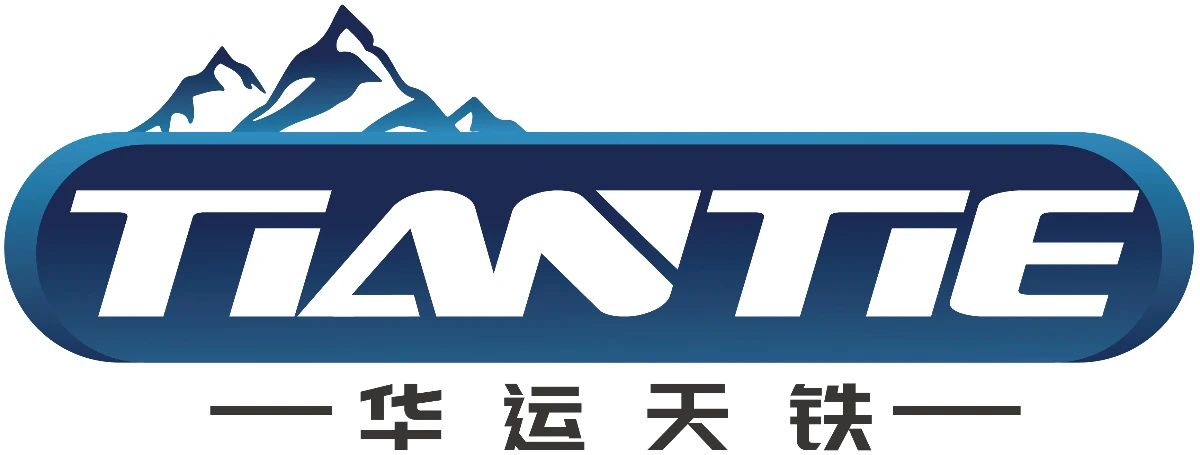
8.2 Bridgestone
One of the world’s largest rubber manufacturers, Bridgestone applies its deep material science expertise to gravel conveyor belts. Their belts are renowned for high tensile strength, low elongation rates, and superior resistance to cuts and impacts, making them a top choice for demanding mining and quarrying operations worldwide.
8.3 Phoenix Conveyor Belt Systems
Phoenix specializes in high-tech, high-performance conveyor belts, especially for extreme conditions. Their belts are engineered to handle high-impact loads and abrasive materials, with a focus on ultra-long-distance transport and energy-efficient designs. Phoenix belts have been used in some of the world’s longest and most challenging conveyor projects.
8.4 ContiTech
Part of Continental AG, ContiTech leads in producing gravel conveyor belts with superior durability and performance. Their pre-tensioned steel cord belts keep elongation under 0.8%, making them ideal for long-distance, high-stress projects.
8.5 Fenner Dunlop
Fenner Dunlop is recognized for high-quality custom belt solutions. Their abrasion-resistant covers, MSHA-certified, have set industry records like 17,000 continuous hours in iron ore transport without major repairs, highlighting their commitment to longevity.
8.6 Flexco
Flexco enhances system reliability through innovative mechanical fastening solutions. Their triple-wave fasteners achieve 85% of belt strength while slashing installation times by 70%, offering both speed and strength in demanding field conditions.
9. Gravel Conveyor Belt Replacement Parts: Key Indicators and Maintenance Standards
Maintaining a gravel conveyor belt system isn’t just about reacting to failures—it’s about recognizing early warning signs and acting before small problems become expensive shutdowns. Here’s what to watch for:
9.1 Conveyor Belt Body
The belt surface handles constant friction and pressure. If the rubber cover wears down to less than 70% of its original thickness, or cracks stretch longer than 50mm across the surface, it’s time for action. Once the remaining cover drops below 3mm, tensile strength can weaken by 20% or more, accelerating edge wear and risking sudden belt failure. Regular inspections help spot these issues before they cause major downtime.

9.2 Rollers and Idlers
Rollers keep the belt moving straight. When the drive pulley surface wears down by 2mm or shows pits over 5mm wide, friction loss kicks in, making the system work harder. If a roller’s movement wobbles beyond 0.6mm, the belt will start snaking side to side—leading to uneven loading and faster wear. Upgrading to ceramic-coated rollers, especially in dusty conditions, extends roller life beyond 20,000 operating hours.

9.3 Pulleys, Bearings, Motors, and Drive Units
The drive system carries the heaviest workload. Bearings running hotter than 85°C or motors vibrating above 4.5mm/s are strong signs of trouble. Gearboxes also need attention: if gear teeth show more than 15% surface pitting or cracks near the root, it’s time to replace before a full system failure happens.

9.4 Auxiliary Functional Components
Scrapers, cleaners, skirt seals, and tensioners are often overlooked—but they’re critical to protecting the belt. A scraper blade worn down by half loses cleaning power, letting fine dust grind into the belt surface. Skirt seals that harden or lose elasticity leak material, increasing mess and belt wear. Tensioners with unstable hydraulic pressure cause slippage and uneven tension distribution, adding stress across the entire system.

Catching these indicators early—and responding based on clear technical standards—keeps gravel conveyor belts running longer, cleaner, and far more efficiently.
10. Common Questions About Gravel Conveyor Belts
1. When should a conveyor belt be replaced immediately?
Certain warning signs mean a gravel conveyor belt should be replaced without delay:
- Core damage: If steel cords are exposed by more than 100mm or if fabric plies are torn through more than three layers, the structural strength is severely compromised (per ISO 14890).
- Edge wear: If transverse cracks stretch across one-third of the belt width or edge wear progresses faster than 2mm per month, further use could trigger belt failure.
- Performance loss: A surface hardness drop below Shore A 50, or a dynamic bonding strength below 8kN/m (ISO 252 standard), signals a belt that is no longer safe for continued operation.
2. What are the three most common types of conveyor belt materials?
Rubber Conveyor Belts
- Features: A blend of natural and synthetic rubbers offering excellent abrasion resistance (150–200mm³ per DIN 53516) and operating effectively from -25°C to +120°C.
- Applications: Ideal for heavy-duty industries like mining and port loading, particularly where materials have hardness levels up to 8 Mohs.
PVC Conveyor Belts
- Features: Made from polyvinyl chloride, these belts handle strong chemical exposures (pH 2–12) with ease, though their heat resistance caps at around 80°C. Light, flexible, and easy to maintain, they are built for operations needing strict hygiene control.
- Applications: Common in food handling, light packaging, and warehouse automation, but not recommended for abrasive or high-impact materials.
PU Conveyor Belts
- Features: With a polyurethane cover and a polyester core, these belts offer superior tear strength (up to 200N/mm) and very low friction (around 0.25).
- Applications: Best suited for transporting sensitive goods like electronics, especially in systems with steep inclines over 30°.
3. What is the average price range for conveyor belts?
- Rubber Conveyor Belts:
Standard EP fabric belts (4-ply, 1m wide) typically cost between $18–25 per running meter. Steel cord belts (ST6300 grade) range from $35–50 per meter. - PVC Conveyor Belts:
Food-grade PVC belts, around 3mm thick, are priced between $12–20 per meter. - PU Conveyor Belts:
Thin, anti-static PU belts cost approximately $25–40 per meter.
(Note: Products carrying MSHA or FDA certifications often include a 20%–35% premium.)
- Rubber Conveyor Belts:
4. What are the slope limits for conveyor belt installation?
- Flat belts without sidewalls:
These belts are best kept on slopes up to 15°. Beyond that, material slippage increases above 8%, risking inefficiencies and spills. - Deep-trough belts(with 45° groove angles):
These systems can handle inclines up to 25°, especially when combined with anti-slip teeth designs for better material control. - Corrugated sidewall belts:
Designed for extreme slopes up to 35°, but require anti-roll-back panels every 20 meters according to DIN 22101 standards to ensure safe transport.
- Flat belts without sidewalls:






